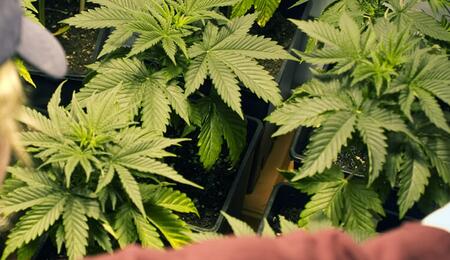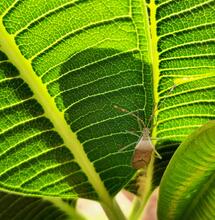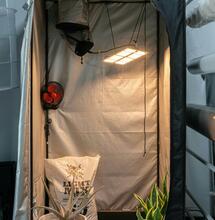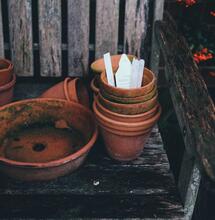Combating Nutrient Deficiencies
11 Oct 2018

Not every nutrient solution on the market today will be able to cover every base when it comes to nutrient completeness. Try to find a nutrient formula that has as wide a range of essential nutrients as possible. It is recommended that you purchase a nutrient formula for the rooting/cloning stage, the green foliage growth stage and the budding stage.
While this might sound like overkill, in fact it is not. Going as far as purchasing a good hormone supplement for each growing stage is a good idea. This is highly recommended when sprouting from seeds or rooting a newly cut clone. Hormone supplements can speed up root growth, ensuring a large and well taken care of plant that will have a high yield when harvesting time comes around.
Every seed that takes root has enough trace elements in it to last until middle age. After that, trace elements must be introduced to the nutrient solution to keep the plant healthy. If the plant is starting from a clone, it is advised that trace elements be introduced in this early stage when roots are forming and trace elements are essential to future healthy growth.
 The most common deficiency is Nitrogen. This is because a fast growing plant such as marijuana needs tons of nitrogen to ensure full growth. Nitrogen is the only truly essential element to ensure healthy and prolific green mass growth. Know a Nitrogen deficiency by having the stems grow an unhealthy red and the leaves growing yellow. Adding Nitrogen will cure this malady in a day or two after upping the Nitrogen content to a higher level. The affected parts of the plant, however, are damaged permanently. If a leaf is pure yellow, the best thing to do is simply cut off the affected leaves. This is so the plant doesn’t expend energy trying to repair the damaged leaf. If there is only one or two fingers of the leaf that are yellow, cut those yellow leaves off and leave the fingers that are still green.
Phosphorous is another essential element that has to have an eye kept on it. It is one of the most common nutrient deficiencies that will plague your green. At first the plant will present with red stems and deformed leaves. Oddly enough, some leaves will actually appear too green. Compare an older growth leaf with a newly grown leaf to spot this deficiency. If any leaves are yellow, prune them off.
Another issue that might be run into is a Potassium deficiency. A deficiency of this sort might be mistaken as a phosphorous deficiency. Know the difference between the two when the leaves start to turn under themselves. The edges and point of the whole leaf will turn under. After increasing the Potassium, it may be beneficial to prune the yellow leaves. You’ll notice a reduction in the yellowing of the leaves a day or two after introducing more Potassium.
Noticing round yellow spots on the leaves is a common way to spot a calcium deficiency. For this common malady, foliar feed one teaspoon of dolomitic lime per liter of water. Marijuana always likes a good misting, but this time it’s for a pointed reason. If this malady is identified quickly, you won’t have to trim the lower leaves. If it hasn’t been identified until holes have developed in the leaves, you’ll have to trim the leaves. Use a paper hole punch to remove the yellow areas. This is because the yellowish areas may rot, stunting the growth of the plant and may also add a moldy odour to the buds later on.
One of the hardest maladies to spot is a Sulphur deficiency. It presents as an oddly yellowed leaf. It looks as though it is transparent, but with the yellow part being within a semitransparent green layer. Foliar feeding with 2% Epsom salts in a liter of water will combat this issue. Sulphur deficiencies, if caught early, won’t affect the plant all that much. If left too long, though, the leaf will die.
If the leaves are whitening and the veins within the leaf are dark, you need to increase the amount of magnesium in the nutrient solution. This common affliction is one that occurs within the green growth stage and is easily cured with a simple increase in magnesium in your nutrient solution. If there is too much magnesium in the nutrient solution, the top leaves will grow yellow and die. To combat this, lower the magnesium in the nutrient solution and add manganese. Also foliar feed with a pH balanced solution containing manganese.
Iron is considered a trace chemical, but when the plant runs out of iron, the leaves will whiten and the veins will grow dark. To combat this, add a good trace element solution to your nutrient. Iron is famous for combining chemically with the other constituent parts of your nutrient solution, but is still an essential element that must be present in the nutrient solution.
If new growth is appearing burnt or is a slimy looking brown, there is a boron deficiency in the nutrient solution. Boron is a trace element, so add just a little bit to your nutrient solution. The most common source of boron is boric acid, so make sure the nutrient solution is pH balanced before it is fed it to the plants.
No single nutrient solution is perfect. There will always be holes in the nutrient’s makeup and as such an eye has to be kept on your green. The elements, their identification and their remedies as they are stated here will help ensure a good crop no matter if it’s 3 or 30 plants being grown. Combating nutrient deficiencies is an easy affair if an eye is kept on the crop.
By Thomas Valentine
The most common deficiency is Nitrogen. This is because a fast growing plant such as marijuana needs tons of nitrogen to ensure full growth. Nitrogen is the only truly essential element to ensure healthy and prolific green mass growth. Know a Nitrogen deficiency by having the stems grow an unhealthy red and the leaves growing yellow. Adding Nitrogen will cure this malady in a day or two after upping the Nitrogen content to a higher level. The affected parts of the plant, however, are damaged permanently. If a leaf is pure yellow, the best thing to do is simply cut off the affected leaves. This is so the plant doesn’t expend energy trying to repair the damaged leaf. If there is only one or two fingers of the leaf that are yellow, cut those yellow leaves off and leave the fingers that are still green.
Phosphorous is another essential element that has to have an eye kept on it. It is one of the most common nutrient deficiencies that will plague your green. At first the plant will present with red stems and deformed leaves. Oddly enough, some leaves will actually appear too green. Compare an older growth leaf with a newly grown leaf to spot this deficiency. If any leaves are yellow, prune them off.
Another issue that might be run into is a Potassium deficiency. A deficiency of this sort might be mistaken as a phosphorous deficiency. Know the difference between the two when the leaves start to turn under themselves. The edges and point of the whole leaf will turn under. After increasing the Potassium, it may be beneficial to prune the yellow leaves. You’ll notice a reduction in the yellowing of the leaves a day or two after introducing more Potassium.
Noticing round yellow spots on the leaves is a common way to spot a calcium deficiency. For this common malady, foliar feed one teaspoon of dolomitic lime per liter of water. Marijuana always likes a good misting, but this time it’s for a pointed reason. If this malady is identified quickly, you won’t have to trim the lower leaves. If it hasn’t been identified until holes have developed in the leaves, you’ll have to trim the leaves. Use a paper hole punch to remove the yellow areas. This is because the yellowish areas may rot, stunting the growth of the plant and may also add a moldy odour to the buds later on.
One of the hardest maladies to spot is a Sulphur deficiency. It presents as an oddly yellowed leaf. It looks as though it is transparent, but with the yellow part being within a semitransparent green layer. Foliar feeding with 2% Epsom salts in a liter of water will combat this issue. Sulphur deficiencies, if caught early, won’t affect the plant all that much. If left too long, though, the leaf will die.
If the leaves are whitening and the veins within the leaf are dark, you need to increase the amount of magnesium in the nutrient solution. This common affliction is one that occurs within the green growth stage and is easily cured with a simple increase in magnesium in your nutrient solution. If there is too much magnesium in the nutrient solution, the top leaves will grow yellow and die. To combat this, lower the magnesium in the nutrient solution and add manganese. Also foliar feed with a pH balanced solution containing manganese.
Iron is considered a trace chemical, but when the plant runs out of iron, the leaves will whiten and the veins will grow dark. To combat this, add a good trace element solution to your nutrient. Iron is famous for combining chemically with the other constituent parts of your nutrient solution, but is still an essential element that must be present in the nutrient solution.
If new growth is appearing burnt or is a slimy looking brown, there is a boron deficiency in the nutrient solution. Boron is a trace element, so add just a little bit to your nutrient solution. The most common source of boron is boric acid, so make sure the nutrient solution is pH balanced before it is fed it to the plants.
No single nutrient solution is perfect. There will always be holes in the nutrient’s makeup and as such an eye has to be kept on your green. The elements, their identification and their remedies as they are stated here will help ensure a good crop no matter if it’s 3 or 30 plants being grown. Combating nutrient deficiencies is an easy affair if an eye is kept on the crop.
By Thomas Valentine
 The most common deficiency is Nitrogen. This is because a fast growing plant such as marijuana needs tons of nitrogen to ensure full growth. Nitrogen is the only truly essential element to ensure healthy and prolific green mass growth. Know a Nitrogen deficiency by having the stems grow an unhealthy red and the leaves growing yellow. Adding Nitrogen will cure this malady in a day or two after upping the Nitrogen content to a higher level. The affected parts of the plant, however, are damaged permanently. If a leaf is pure yellow, the best thing to do is simply cut off the affected leaves. This is so the plant doesn’t expend energy trying to repair the damaged leaf. If there is only one or two fingers of the leaf that are yellow, cut those yellow leaves off and leave the fingers that are still green.
Phosphorous is another essential element that has to have an eye kept on it. It is one of the most common nutrient deficiencies that will plague your green. At first the plant will present with red stems and deformed leaves. Oddly enough, some leaves will actually appear too green. Compare an older growth leaf with a newly grown leaf to spot this deficiency. If any leaves are yellow, prune them off.
Another issue that might be run into is a Potassium deficiency. A deficiency of this sort might be mistaken as a phosphorous deficiency. Know the difference between the two when the leaves start to turn under themselves. The edges and point of the whole leaf will turn under. After increasing the Potassium, it may be beneficial to prune the yellow leaves. You’ll notice a reduction in the yellowing of the leaves a day or two after introducing more Potassium.
Noticing round yellow spots on the leaves is a common way to spot a calcium deficiency. For this common malady, foliar feed one teaspoon of dolomitic lime per liter of water. Marijuana always likes a good misting, but this time it’s for a pointed reason. If this malady is identified quickly, you won’t have to trim the lower leaves. If it hasn’t been identified until holes have developed in the leaves, you’ll have to trim the leaves. Use a paper hole punch to remove the yellow areas. This is because the yellowish areas may rot, stunting the growth of the plant and may also add a moldy odour to the buds later on.
One of the hardest maladies to spot is a Sulphur deficiency. It presents as an oddly yellowed leaf. It looks as though it is transparent, but with the yellow part being within a semitransparent green layer. Foliar feeding with 2% Epsom salts in a liter of water will combat this issue. Sulphur deficiencies, if caught early, won’t affect the plant all that much. If left too long, though, the leaf will die.
If the leaves are whitening and the veins within the leaf are dark, you need to increase the amount of magnesium in the nutrient solution. This common affliction is one that occurs within the green growth stage and is easily cured with a simple increase in magnesium in your nutrient solution. If there is too much magnesium in the nutrient solution, the top leaves will grow yellow and die. To combat this, lower the magnesium in the nutrient solution and add manganese. Also foliar feed with a pH balanced solution containing manganese.
Iron is considered a trace chemical, but when the plant runs out of iron, the leaves will whiten and the veins will grow dark. To combat this, add a good trace element solution to your nutrient. Iron is famous for combining chemically with the other constituent parts of your nutrient solution, but is still an essential element that must be present in the nutrient solution.
If new growth is appearing burnt or is a slimy looking brown, there is a boron deficiency in the nutrient solution. Boron is a trace element, so add just a little bit to your nutrient solution. The most common source of boron is boric acid, so make sure the nutrient solution is pH balanced before it is fed it to the plants.
No single nutrient solution is perfect. There will always be holes in the nutrient’s makeup and as such an eye has to be kept on your green. The elements, their identification and their remedies as they are stated here will help ensure a good crop no matter if it’s 3 or 30 plants being grown. Combating nutrient deficiencies is an easy affair if an eye is kept on the crop.
By Thomas Valentine
The most common deficiency is Nitrogen. This is because a fast growing plant such as marijuana needs tons of nitrogen to ensure full growth. Nitrogen is the only truly essential element to ensure healthy and prolific green mass growth. Know a Nitrogen deficiency by having the stems grow an unhealthy red and the leaves growing yellow. Adding Nitrogen will cure this malady in a day or two after upping the Nitrogen content to a higher level. The affected parts of the plant, however, are damaged permanently. If a leaf is pure yellow, the best thing to do is simply cut off the affected leaves. This is so the plant doesn’t expend energy trying to repair the damaged leaf. If there is only one or two fingers of the leaf that are yellow, cut those yellow leaves off and leave the fingers that are still green.
Phosphorous is another essential element that has to have an eye kept on it. It is one of the most common nutrient deficiencies that will plague your green. At first the plant will present with red stems and deformed leaves. Oddly enough, some leaves will actually appear too green. Compare an older growth leaf with a newly grown leaf to spot this deficiency. If any leaves are yellow, prune them off.
Another issue that might be run into is a Potassium deficiency. A deficiency of this sort might be mistaken as a phosphorous deficiency. Know the difference between the two when the leaves start to turn under themselves. The edges and point of the whole leaf will turn under. After increasing the Potassium, it may be beneficial to prune the yellow leaves. You’ll notice a reduction in the yellowing of the leaves a day or two after introducing more Potassium.
Noticing round yellow spots on the leaves is a common way to spot a calcium deficiency. For this common malady, foliar feed one teaspoon of dolomitic lime per liter of water. Marijuana always likes a good misting, but this time it’s for a pointed reason. If this malady is identified quickly, you won’t have to trim the lower leaves. If it hasn’t been identified until holes have developed in the leaves, you’ll have to trim the leaves. Use a paper hole punch to remove the yellow areas. This is because the yellowish areas may rot, stunting the growth of the plant and may also add a moldy odour to the buds later on.
One of the hardest maladies to spot is a Sulphur deficiency. It presents as an oddly yellowed leaf. It looks as though it is transparent, but with the yellow part being within a semitransparent green layer. Foliar feeding with 2% Epsom salts in a liter of water will combat this issue. Sulphur deficiencies, if caught early, won’t affect the plant all that much. If left too long, though, the leaf will die.
If the leaves are whitening and the veins within the leaf are dark, you need to increase the amount of magnesium in the nutrient solution. This common affliction is one that occurs within the green growth stage and is easily cured with a simple increase in magnesium in your nutrient solution. If there is too much magnesium in the nutrient solution, the top leaves will grow yellow and die. To combat this, lower the magnesium in the nutrient solution and add manganese. Also foliar feed with a pH balanced solution containing manganese.
Iron is considered a trace chemical, but when the plant runs out of iron, the leaves will whiten and the veins will grow dark. To combat this, add a good trace element solution to your nutrient. Iron is famous for combining chemically with the other constituent parts of your nutrient solution, but is still an essential element that must be present in the nutrient solution.
If new growth is appearing burnt or is a slimy looking brown, there is a boron deficiency in the nutrient solution. Boron is a trace element, so add just a little bit to your nutrient solution. The most common source of boron is boric acid, so make sure the nutrient solution is pH balanced before it is fed it to the plants.
No single nutrient solution is perfect. There will always be holes in the nutrient’s makeup and as such an eye has to be kept on your green. The elements, their identification and their remedies as they are stated here will help ensure a good crop no matter if it’s 3 or 30 plants being grown. Combating nutrient deficiencies is an easy affair if an eye is kept on the crop.
By Thomas Valentine



.png)